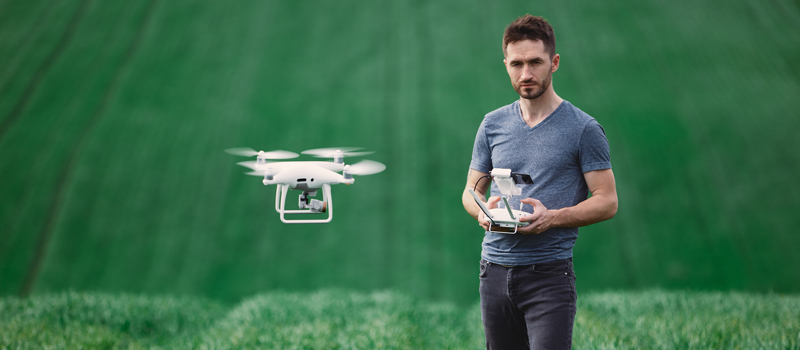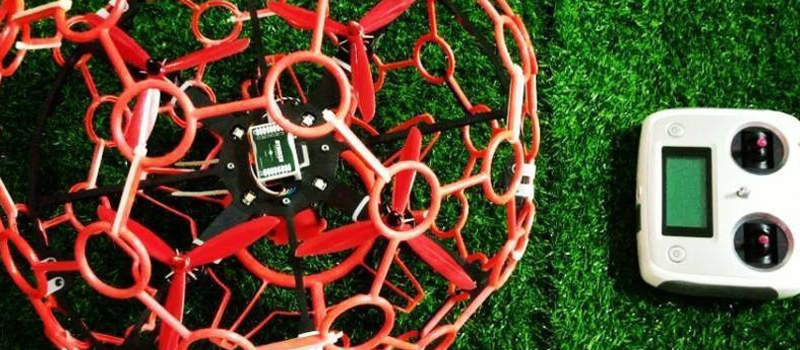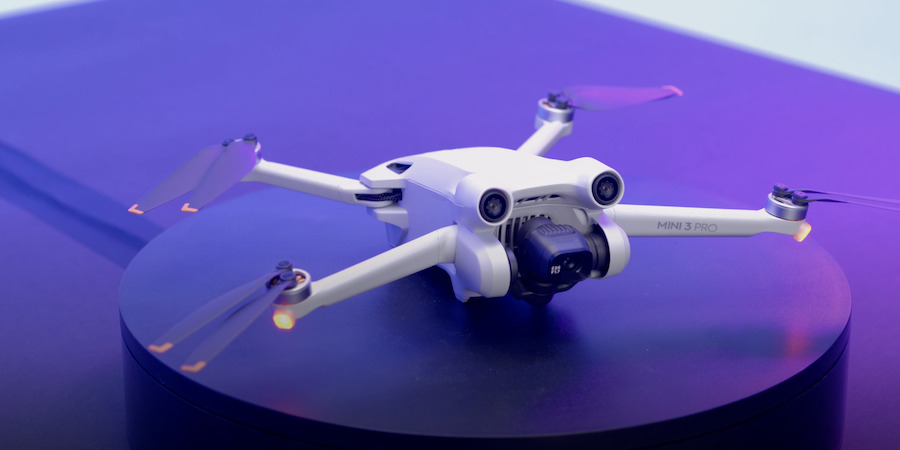With the launch of the Avata, DJI is realizing their first CineWhoop drone. This move is reminiscent of when the DJI FPV was launched earlier this year.
Of these two “unconventional” DJI drones, which one is better? Is the DJI Avata something that you should be holding out for, or should you go ahead and get a DJI FPV? Check out our side-by-side comparison.
FPV vs. CineWhoop drones
Just comparing the appearance of the DJI FPV and DJI Avata makes it obvious that these are two very different drones. Both these drones appeal to smaller drone markets that have so far been underserved by the large commercial drone brands – FPV drones and CineWhoop drones.
FPV drones, as their name suggests, are designed to be piloted in FPV mode. This makes flight more impressive, but more importantly, allows for very fast and precise maneuvers. FPV drones are built for high-speed races with high responsiveness and low latency transmission. They are also built to be tough enough to withstand high-speed crashes.
CineWhoop drones are almost the exact opposite. They are built for slow and stable flight, allowing for smooth aerial filmmaking. Camera quality is a major design consideration for CineWhoop drones. A visually distinct feature of CineWhoop drones is the ducts around the propellers that help in keeping flight safe, even in tight or indoor spaces.
Communities have been built around the use of FPV drones and CineWhoop drones, and these communities have mostly thrived by building DIY drones from component parts. DJI is changing the game by offering these drones in pre-built off-the-shelf models made with high-quality parts. It has also been a slight departure from DJI’s successful line of ultra-portable camera drones.
Design and build quality
| Parameter | DJI FPV | DJI Avata |
| Size | 255 x 312 x 127 millimeters | 795 grams |
| Weight | 180 x 180 x 180 millimeters | 408 grams |
The DJI FPV measures 255 x 312 x 127 millimeters and weighs 795 grams. This makes the DJI FPV substantially larger and heavier than most other FPV drones, likely because of all the extra hardware that you would normally not find in a DIY FPV drone.
The propeller arms of the DJI FPV do not fold inward and have permanent landing feet. The propellers have three blades, helping in making the drone more responsive. It has a front-facing camera consistent with the standard FPV drone design. The body is mostly made of black and gray plastic with a rounded profile that is more prominent towards the front of the drone.
The DJI FPV has been around for several months now and so many tests have vouched for how incredibly tough it is. This is a drone that can crash head-on at maximum Sport Mode speed and still go back to flying. Should some of the drone’s components break, they can be replaced by the user in a callback to how FPV drones are repaired when they break apart.
The DJI Avata is expected to measure 180 x 180 x 180 millimeters and weighs 408 grams. Although significantly smaller and lighter, the Avata does not quite go below the threshold for avoiding drone registration. The Avata is just small enough to maneuver through small spaces, which is pretty much the main use case of CineWhoop drones.
Leaked photos of the Avata show a blocky body with a top-mounted battery and a front-facing camera. True to the CineWhoop design, the Avata features propeller ducts with integrated small landing gear. The ducts of the Avata are less prominent compared to standard CineWhoop drones, but detailed testing will have to be done to determine if this has a huge effect on flight performance.
While durability typically is not the emphasis of CineWhoop drones, they are built to withstand minor crashes when flying in tight spaces. They also are not expected to fly very fast, so crashes should not be very bad. The same design consideration is expected of the DJI Avata, although DJI offers propeller duct replacements in case of damage.
With massive design differences, neither the DJI FPV nor the Avata really holds the advantage. The FPV was built for speed and durability, while the Avata was for flight stability and safety. The choice comes down to the specific use case of the pilot.
Camera
| Parameter | DJI FPV | DJI Avata |
| Sensor | 1/2.3” CMOS | 1/1.7” CMOS |
| Video resolution | 4K @ 60 fps, 1080p @ 120 fps | 4K @ 60 fps, 2.7K @ 120 fps, 1080p @ 120 fps |
| Field of view | 150 degrees | 155 degrees |
| Aperture | f/2.8 | f/2.8 |
| ISO | 100 – 12800 | 100 – 25600 |
| Stabilization | Hybrid (one-axis gimbal + electronic) | Hybrid (one-axis gimbal + RockSteady) |
| Built-in memory | None, expandable via microSD card | 20 GB, expandable via microSD card |
Camera quality has always been the strong suit of DJI, and they leveraged it well in both the FPV and Avata drones. The DJI FPV comes with an image sensor that is the same size as that found in the DJI Mini 2. The Avata, being a filmmaking-centric drone, comes with a slightly larger image sensor.
Both drones can record videos in 4K resolution and 60 fps, but only the Avata can record 2.7K resolution at 120 fps. As both drones are meant to be piloted in FPV, the cameras have very wide fields of view from 150 to 155 degrees. Both drone cameras have fixed aperture and are aided by a combination of mechanical and electronic image stabilization. The Avata has a much wider ISO range, making it suitable for capturing videos in low-lit settings.
The DJI FPV has no built-in memory, giving the clear advantage to the modest but substantial 20-GB internal memory of the Avata. This is not really a huge issue considering that both drones can be expanded with microSD cards.
The larger image sensor and wider ISO range gives the DJI Avata a clear advantage in terms of camera quality. This is not really surprising, as a CineWhoop drone’s main objective is to capture videos.
Flight performance
| Parameter | DJI FPV | DJI Avata |
| Flight modes | Normal, Sport, Manual | Normal, Sport, Manual |
| Max speed | 15 m/s (Normal) 27 m/s (Sport) 39 m/s (Manual) | 8 m/s (Normal) 14 m/s (Sport) 27 m/s (Manual) |
| Flight stabilization | GPS | GPS |
Both the FPV and Avata offer the standard Normal and Sport flight modes, with the much more challenging Manual mode also thrown in. There are speed limitations for each flight mode, but the Avata is capped at much lower values. This is consistent with the different objectives of these two drones.
Both drones also benefit from GPS-aided stabilization – something that DIY drones typically do not have. This means that the drones can hover in place without any user input, making them much more accessible to beginner drone pilots. Manual mode will appeal to drone pilots who have experience in flying FPV or CineWhoop drones.
If you prioritize speed, then the DJI FPV is the clear winner in this category. However, the DJI Avata offers slow and steady flight, although you won’t be winning any drone races.
Flight time and battery life
| Parameter | DJI FPV | DJI Avata |
| Battery capacity | 2000 mAh | 2420 mAh |
| Max flight time | 20 minutes | 18 minutes |
The DJI FPV has a rated maximum flight time of 20 minutes while the Avata can fly up to 18 minutes on a single battery cycle. This may not seem impressive compared to the Mavic drones, but these are substantially longer compared to their DIY counterparts.
The batteries of both drones are designed as the DJI standard “Intelligent” flight batteries. This means that the batteries have self-discharge functions that activate when they are kept in storage for a prescribed period, making the batteries last longer.
Both drones have multi-battery charging hubs as accessories. This is essential considering how you are going to need multiple batteries for a satisfying drone flight session. As with previous iterations of the Intelligent charging hub, it automatically prioritizes charging batteries to get your drone back to the sky as quickly as possible.
Although the flight time stated by DJI is impressive, the actual flight time is likely to be shorter. Flying manual at high speed and doing fancy maneuvers can drain a lot of power from the battery. Many owners of the DJI FPV find that they can only fly their drones for about 10 minutes when doing aggressive flight. The same disparity can be expected of the DJI Avata.
Transmission and remote controller
| Parameter | DJI FPV | DJI Avata |
| Controller options | DJI FPV Remote Controller, DJI Motion Controller | Standard Remote Controller, DJI Motion Controller |
| Transmission technology | OcuSync 3.0 | No info |
| Transmission modes | Low-latency HD Mode Smooth Mode Audience Mode | No info |
By default, the DJI FPV comes with an appropriate compact remote controller. It is about the size of the redesigned controller that comes with the DJI Mini 2 but has protruding handles similar to a game controller. As the FPV is designed to be piloted with FPV goggles, the controller has neither a built-in screen nor a provision for an external device.
DJI has made several changes to the transmission technology of the DJI FPV to make the flight experience as responsive as possible. The switch from analog to digital transmission, combine with OcuSync 3.0, reduces latency without sacrificing transmission range. The drone supports dual-frequency transmission with a maximum 50-Mbps bitrate.
DJI FPV also offers the option to switch between transmission modes, prioritizing either low latency or high-resolution video. There is also a mode that allows other FPV goggles to “piggyback” on your flight as an audience.
The DJI Avata has been heavily marketed as being compatible with an intuitive Motion Controller. The controller resembles a flight stick that presumably will make control of the Avata much easier. This controller is actually also an option for the DJI FPV drone.
Details are still scarce on the transmission technology used for the DJI Avata, or if it offers any transmission modes in the fashion of DJI FPV. We will report on these details when they become available.
FPV goggles
| Parameter | DJI FPV | DJI Avata |
| FPV Goggles options | DJI FPV Goggles V2 | DJI Goggles 2, DJI FPV Goggles V2 |
| Size | 202 x 126 x 110 millimeters | No info |
| Weight | 420 grams | 290 grams (DJI Goggles 2) |
| Screen resolution | 810p | No info |
| Framerate | 120 fps (Low latency mode) 60 fps (High-quality mode) | 100 fps (Low latency mode) 60 fps (High-quality mode) |
| Latency | 28 ms | No info |
| Battery life | 110 minutes | 120 minutes |
Both the DJI FPV and Avata are meant to be piloted with FPV goggles, making flights much more immersive and allowing for very precise control. For this reason, compatibility with FPV goggles and FPV performance are two very important metrics to assess these drones.
The DJI FPV Goggles V2 was introduced with the DJI FPV. These goggles are distinct with their four antennas and bug-eyed appearance. Performance-wise, the FPV Goggles V2 has good resolution, high framerate, and low latency. It is powered by a battery pack that has to be connected to the headset via a USB-C cable.
Based on promotional photos, the DJI Avata should also be compatible with the DJI FPV Goggles V2. However, DJI is also introducing a brand-new set of FPV goggles with the Avata, confusingly called the DJI Goggles 2. The photos show a slightly more compact and lighter pair of FPV goggles, although there are no details yet on its performance parameters.
Cross-compatibility gives the DJI Avata a clear advantage in this department. The DJI Goggles 2 seems like a more comfortable pair of FPV goggles, although we are yet to see if this meant compromising on resolution or latency.
Safety
| Parameter | DJI FPV | DJI Avata |
| GPS features | Stabilization, RTH | Stabilization, RTH |
| Obstacle avoidance | Front and bottom | Bottom only |
| Has ADS-B? | Yes | Yes |
Both the DJI FPV and Avata will come with GPS receivers and obstacle avoidance sensors – two features that you normally will not find in their DIIY counterparts. The two drones benefit from GPS-aided stabilization and have Return-to-Home modes that activate in case of low battery power or signal loss.
Both drones also come with obstacle avoidance systems, but they are much more limited than those that you would find in a modern Mavic drone. The DJI FPV has obstacle avoidance sensors on the bottom and front, while the Avata has the sensors only on the bottom side. These sensors are just enough to avoid crashes but do not restrict the drones from flying in enclosed spaces.
Both drones come with AirSense, the DJI feature that uses an ADS-B receiver to warn the drone pilot of any nearby manned aircraft. This feature has become a standard in modern DJI drones and is nice to have if you’re planning to fly in an area with lots of air traffic.
Price
The DJI FPV and Avata are both available in several bundles that come with different sets of accessories. The bundles for the DJI Avata are a bit more complicated because of the different combinations of FPV goggles and controllers. The tables below summarize the pricing schemes for the DJI FPV and DJI Avata and their associated accessories.
| DJI FPV Pricing | ||
| Bundle | What is included | Price |
| Basic | DJI FPV DroneDJI FPV Goggles V2DJI FPV Remote Controller1 Intelligent Flight BatteryGimbal Protector4 Pairs PropellersDJI FPV Goggles BatteryDJI FPV Goggles HeadbandDJI FPV Goggles Foam PaddingDJI FPV Goggles Antenna Spare Control SticksAssortment of cables | $999 |
| Fly More Combo | 2 Intelligent Flight BatteryFPV Battery Charging Hub | + $299 |
| + Motion Controller | DJI Motion ControllerLanyard | + $199 |
| DJI Avata Pricing | ||
| Bundle | What is included | Price |
| Basic | DJI Avata Drone | $629 |
| DJI Goggles 2 | DJI Goggles 2 | $649 |
| DJI Goggles 2 Motion Combo | DJI Goggles 2V1 Motion Controller | $759 |
| DJI Fly Smart Combo | DJI Avata DroneDJI FPV Goggles V2V1 Motion Controller | $1168 |
| DJI Pro-View Combo | DJI Avata DroneDJI Goggles 2V1 Motion Controller | $1388 |
Details are still incomplete on the accessories that will come with the Avata drone basic package but it can be expected to have the usual Intelligent Flight Battery, spare propellers, and connectivity cables.
Both the DJI FPV and Avata are fairly expensive drones, especially for a person who is setting out to buy their first drone. The FPV is a little more affordable at $999 for the bundle that has all the basic accessories to fly the drone out of the box. If you want to fly the DJI Avata right away, your best bet would be the Fly Smart Combo at $1168.
It’s interesting to note that it’s possible to buy the Avata drone as a standalone product. This is a practical option for those who already have the DJI FPV Controller and FPV Goggles V2, as even the FPV Controller is rumored to be compatible with the Avata. Of course, you can still get the upgraded DJI Goggles 2 and the V1 Motion Controller, but these two accessories together will cost more than the Avata drone.
Which one should you get?
It should actually be very easy to choose between the DJI FPV and the DJI Avata because they are two very different drones. One drone is built for speed and maneuverability, while the other is for stable flight and cinematic filmmaking. These are two different schools of thought and the choice of which drone to buy depends on which type of drone flight you prefer.
Many people are intrigued with these drones mainly because of the concept of FPV flight. This is actually understandable – the experience of FPV flight is amazing and something that cannot be adequately described with words. Both drones offer a premium FPV flight experience and are ready to fly off the shelf. This is great for those who just want to experience flying in FPV but do not want to have to build a drone completely from scratch.
The Avata’s filmmaking capabilities and smooth flight may offer more for beginners, but the higher price tag also has to be considered. The FPV is ideal for those who have used drones before and are looking for a new and faster flight experience.
Those who are experienced in flying DIY CineWhoop or DJI drones may find themselves underwhelmed with DJI drones. The hardware components are great, but these DJI drones have no room for customization. You will also have to deal with the usual inconveniences of flying DJI drones, such as possibly having to do an unlock when operating in No-Fly Zones.



